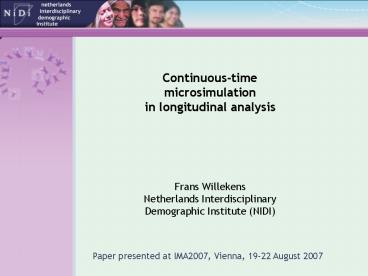Continuoustime microsimulation in longitudinal analysis - PowerPoint PPT Presentation
1 / 17
Title:
Continuoustime microsimulation in longitudinal analysis
Description:
Quantile function. Parameterize baseline hazard. Two- or three-stage method ... The main tool is the inverse distribution function or quantile function. ... – PowerPoint PPT presentation
Number of Views:45
Avg rating:3.0/5.0
Title: Continuoustime microsimulation in longitudinal analysis
1
Continuous-timemicrosimulationin longitudinal
analysis
- Frans Willekens
- Netherlands Interdisciplinary
- Demographic Institute (NIDI)
Paper presented at IMA2007, Vienna, 19-22 August
2007
2
MicrosimulationSampling a virtual population
- Real population vs virtual population
- Virtual population is generated by a mathematical
model - If model is realistic virtual population real
population - Population dynamics
- Model describes dynamics of a virtual (model)
population - Macrosimulation dynamics at population level
- Microsimulation dynamics at individual level
3
Types of observation (sample)
- Prospective observation of a real population
longitudinal observation - In discrete time panel study
- In continuous time follow-up study (event
recorded at time occurrence) - Random sample (survey vs census)
- Cross-sectional
- Longitudinal individual life histories
4
Longitudinal data analysisPath dependence
- Study of sequences of events, sequences of states
(lifepaths, trajectories, pathways) - Transition data transition models or multistate
survival analysis or multistate event history
analysis - Discrete time
- Transition probabilities
- Probability models (e.g. logistic regression
probit) - Continuous time
- Transition rates
- Rate models (e.g. exponential model Gompertz
model Cox model) - Sequence analysis Abbott represent trajectory
as a character string and compare sequences
5
Why continuous time? When exact dates are
important
- Some events trigger other events. Dates are
important to determine causal links. - Duration analysis duration measured precisely or
approximately - Birth intervals
- Employment and unemployment spells
- Poverty spells
- Duration of recovery in studies of health
intervention - To resolve problem of interval censoring
- Time of an event of interest is often not known
exactly but is only known to have occurred within
a defined interval.
6
What is continuous time?
- Precise date (month, day, second)
- Month is often adequate approximation gt discrete
time converges to continuous time
7
Time to event (waiting time) models in
microsimulation
- Examples of simulation models with events in
continuous time (time to event) - Socsim (Berkeley)
- Lifepaths (Statistics Canada)
- Pensim ((US Dept. of Labor)
Choice of continuous time is desirable from a
theoretical point of view. (Zaidi and Rake, 2001)
8
Time to event (waiting time) models in
microsimulation
Time to event is generated by transition rate
model
- Exponential model (piecewise) constant
transition (hazard) rate - Gompertz model transition rate changes
exponentially with duration - Weibull model power function of duration
- Cox semiparametric model
- Specialized models, e.g. Coale-McNeil model
9
Time to event is generated by transition rate
modelHow?
Inverse distribution function or Quantile function
10
Quantile functions
- Exponential distribution (constant hazard rate ?)
- Distribution function
- Quantile function
- Cox model
- Distribution function
- Quantile function
Parameterize baseline hazard
11
Two- or three-stage method
- Stage 1 draw a random number (probability) from
a uniform distribution - Stage 2 determine the waiting time from the
probability using the quantile function - Stage 3
- in case of multiple (competing) events event
with lowest waiting time wins - in case of competing risks (same event, multiple
destinations) draw a random number from a
uniform distribution
12
Illustration
- If the transition rate is 0.2, what is the median
waiting time to the event?
The expected waiting time is
13
IllustrationExponential model with ?0.2 and
1,000 draws
14
(No Transcript)
15
Multiple origins and multiple destinationsState
probabilities derived from transition rates
16
Lifepaths during 10-year periodSample of 1,000
subject ?0.2
17
Conclusion
- Microsimulation in continuous time made simple by
methods of survival analysis / event history
analysis. - The main tool is the inverse distribution
function or quantile function. - Duration and transition analysis in virtual
populations not different from that in real
populations































